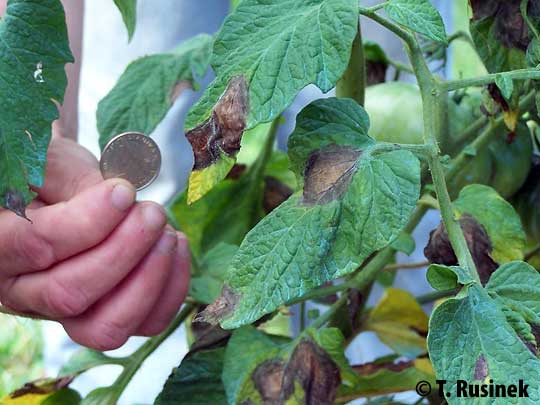
There is no tomato cultivar that is 100% immune to early blight, but there are several that have been bred for resistance against stem or leaf infections. 2: Plant varieties that have some resistance to Early Blight

In addition to trellising, make sure you are planting your tomato seedlings at least 18 inches apart from one another so they don’t become a tangled, jungle-y mess later in the season. Trellising your tomato plants is the most effective way to keep air moving between the foliage, and plants that are allowed to spread out and lie on the ground are also more likely to get early blight through soil contact.
#Blight on tomatoes treatment organic how to
How to Tell Early Blight Apart From Other DiseasesĪir flow is key when it comes to preventing fungal infections like early blight, as almost every fungi will thrive in humid, damp, and/or stagnant environments. Both unripe and ripe fruits can be affected, and may eventually drop from the plant.Īlthough early blight is usually associated with older plants, seedlings can also be infected and will show smaller brown spots and lesions on the main stem and leaves. Like the leaf spots, the fruits may develop raised concentric ridges in the sunken area. The fruits of tomato plants infected with early blight will develop large black spots that are usually located close to the stem.

Dark brown rings might form around the stem, and the infected parts may become dry and powdery. Infected stems develop something called collar rot, where the stem a few inches above the soil line becomes soft, brown, and rotten. As it advances, infected parts of the leaves will die, dry, and fall away leaving bare, brown stems or raggedy foliage in its wake. On average, the spots and blotches that develop from early blight are a quarter to half an inch in diameter. The spots typically have concentric rings inside them that give a target or bullseye appearance, and are often surrounded with a light green or yellow halo. The most common symptom of early blight in both seedlings and mature tomato plants is small-ish brown spots developing on the lower leaves. Lower, older growth is most likely to become infected first, until the disease has slowly worked its way up the plant and infected all the foliage. Identifying Early Blight Symptoms on TomatoesĮarly blight affects the leaves, stems, and fruits of tomato plants. It can also live in the soil for around a year, and may overwinter on infected plant debris left in the field before spreading to new plants the following season. There is also some evidence that the flea beetle can transmit early blight to tomatoes.Įarly blight can theoretically occur in any type of weather, but is more likely to spread in damp, wet conditions when temperatures are from 59-80℉. The pathogen enters your plants through small wounds and cuts, and is more likely to infect already vulnerable or sickly plants. Lower leaves are often affected first from rain splashing spores up from the soil surface. solani is more likely to infect potatoes, however, both can infect tomatoes in ideal conditions.Įarly blight can be introduced to your garden by purchasing or saving infected seeds or seedlings, or by spores being blown by the wind or rain and landing on your plants. tomatophila is more likely to infect tomato plants and A.

Early blight is caused by two fungi, Alternaria tomatophila and Alternaria solani.


 0 kommentar(er)
0 kommentar(er)
